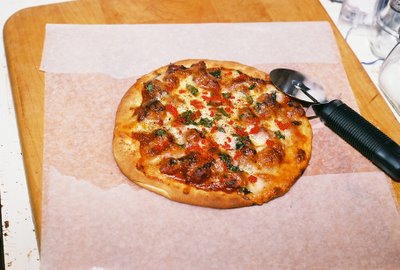Basic Hollandaise Sauce
Hi everybody!
Well, November's almost over. Yikes. Before long, it'll be be Christmas all over again (where did the year go??).
I don't have that much to report this evening. For supper, I'm having a sandwich made from leftover corned beef, and some steamed asparagus (with Hollandaise sauce) on the side. I've prepared a small batch of my wasabi mayonnaise to dress the sandwich (the recipe for it is posted on the Blog...I think it was on November 12th. It's great on grilled tuna, but it works elsewhere, too!).
Hollandaise Sauce is a traditional egg-thickened sauce (as opposed to thickening with flour, a cornstarch slurry, a roux, etc. or by reduction). It's not that hard to make, and the home-made variety is MUCH better than the stuff that comes in a jar (or, heaven forbid, in powder form). It's just important to keep a very close eye on things.
Hollandaise Sauce (2 servings; recipe can be multiplied)
(the hardware: you'll need a small saucepan, and a heavy, stainless steel bowl that's wider than the saucepan. The bowl should have a rounded bottom, preferably. And you'll need a whisk)
*2 eggs
*1/2 cup unsalted butter, refrigerated (so it's still firm)
*2 teaspoons lemon juice
*(up to) 1 Tablespoon light cream, heavy cream, or half & half
*a few dashes (about 1/4 to 1/2 teaspoon) Tabasco, or other hot sauce (optional)
* a few crushed/broken ice cubes
*salt, freshly-ground black pepper, and (optional) cayenne pepper, to taste
Start by creating a double-boiler: fill a small saucepan (1.5- or 2-quart) about 1/3 full of water. Put the pan on the stove, over high heat, and allow the water to come to a boil.
Meanwhile, separate the eggs; discard the whites (or save them for some other use...it's up to you). Place the raw yolks into the stainless steel bowl. Add the lemon juice, give everything a quick stir, and set aside until the water is boiling.
In the meantime, cut the butter into small chunks. It doesn't have to be scientific; just so you can add it a little at a time.
When the water boils, it's time to act quickly. Reduce the heat somewhat...down to medium high (you may have to adjust). The idea is to keep the water simmering while you're heating the sauce. Place the bowl with the eggs yolks into the saucepan of water, and proceed to whisk the egg yolk mixture vigorously. You might wish to use an oven mitt, or a towel, to hold the bowl. As soon as the egg yolk mixture takes on a creamy, consistent texture, add a small "chunk" or two of the butter. CONTINUE WHISKING as the butter melts, and becomes incorporated.
It will be necessary to lift the bowl from the saucepan, occasionally, to moderate the heat. But KEEP ON WHISKING! Gradually add the remaining butter, bit by bit, until it has all been incorporated. If you keep "moderating" the temperature---removing the bowl from the heat, then returning it---there should be no problems.
However, if the sauce gets too thick (this is a bad thing), quickly throw in a small chunk of ice (and KEEP WHISKING!). The additional liquid, combined with the slight reduction in temperature, should make the sauce "workable" again.*
When the butter has all been incorporated, turn off the heat under the saucepan. Add enough cream (just a little) to thin the sauce to a consistency you like. A teaspoon or two should be plenty. Season the sauce with salt, pepper, Tabasco, and/or cayenne, to suit your taste (and KEEP WHISKING!).
Serve immediately over asparagus, or whatever cooked vegetable you like. Or, pour some over poached eggs (that's Eggs Benedict!).
(*in the event that your sauce "breaks", or curdles: it's not the end of the world! Simply pour the "broken" sauce into another bowl, and set aside. Wash and thoroughly dry the stainless steel bowl, then separate another 2 eggs. Place the 2 new egg yolks into the stainless steel bowl, and heat them over the double boiler...WHISKING CONSTANTLY, as always. When the egg yolks become creamy, whisk in the original sauce. This ought to smooth the mixture. Be sure to check for seasonings)
Really, it's not as difficult as it sounds!
I hope you enjoy!


